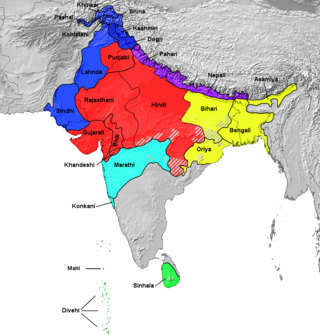인도아리아인
(인도-아리아인에서 넘어옴)
인도아리아인은 인도이란어파 계통의 인도아리아어군을 사용하는 인도유럽인 집단의 총칭이다. 오늘날 약 10여억 명이 넘는 인도아리아인들은 주로 인도를 포함한 남아시아 지역에 거주하고 있으며, 그 중에서도 북인도 지역에 거의 대부분의 인도아리아인들이 살고 있다.
|
| |
 주요 인도아리아어족 언어의 지역별 분포 | |
| 총인구 | |
| 약 12억 1000만 명 | |
| 인구분포 | |
| 8억 5600만 명 이상[1] | |
| 1억 6400만 명 이상[2] | |
| 1억 5000만 명 이상[3] | |
| 2600만 명 이상 | |
| 1400만 명 이상 | |
| 100만 명 이상 | |
| 30만 명 이상 | |
| 언어 | |
| 인도아리아어군 | |
| 종교 | |
| 힌두교, 시크교, 불교, 자이나교, 이슬람교, 기독교 | |
| 민족계통 | |
| 인도이란인 | |
| 기원·발상 | 박트리아-마르기아나 문화 |
| 근연민족 | 이란족 |
인도아리아인의 역사
편집인도아리아인의 원형은 중앙아시아 방면에서 안드로노보 문화와 남쪽에 자리하던 박트리아-마르기아나 문화를 향유하며 유목 생활을 하던 인도유럽인 민족인 인도이란인이다. 이들은 기원전 20세기부터 남쪽과 서쪽으로 이동하기 시작했는데 그 중 남쪽으로 이동한 분파가 펀자브 지방을 거쳐 북인도로 이주해 정착하면서 인도아리아인으로 발전한 것으로 추정하고 있다.
인도아리아제족
편집신화상
편집역사상
편집현재
편집같이 보기
편집참고 서적
편집- Anthony, David W. (2007). 《The Horse The Wheel And Language. How Bronze-Age Riders From the Eurasian Steppes Shaped The Modern World》. Princeton University Press.
- Beckwith, Christopher I. (2009년 3월 16일). 《Empires of the Silk Road: A History of Central Eurasia from the Bronze Age to the Present》. Princeton University Press. ISBN 1400829941. 2016년 3월 5일에 원본 문서에서 보존된 문서. 2014년 12월 30일에 확인함.
- Bryant, Edwin (2001). 《The Quest for the Origins of Vedic Culture》. Oxford University Press. ISBN 0-19-513777-9.
- Loewe, Michael; Shaughnessy, Edward L. (1999). 《The Cambridge History of Ancient China: From the Origins of Civilization to 221 BC》. Cambridge University Press. 87–88쪽. ISBN 0-5214-7030-7. 2016년 3월 5일에 원본 문서에서 보존된 문서. 2013년 11월 1일에 확인함.
- Mallory, JP. 1998. "A European Perspective on Indo-Europeans in Asia". In The Bronze Age and Early Iron Age Peoples of Eastern and Central Asia. Ed. Mair. Washington DC: Institute for the Study of Man.
- Trubachov, Oleg N., 1999: Indoarica, Nauka, Moscow.
- Witzel, Michael (2005), 〈Indocentrism〉, Bryant, Edwin; Patton, Laurie L., 《TheE Indo-Aryan Controversy. Evidence and inference in Indian history》 (PDF), Routledge
외부 링크
편집각주
편집- ↑ “India”. 《The World Factbook》. 2008년 6월 11일에 원본 문서에서 보존된 문서. 2015년 11월 19일에 확인함.
- ↑ “Pakistan”. 《The World Factbook》. 2020년 5월 24일에 원본 문서에서 보존된 문서. 2015년 11월 19일에 확인함.
- ↑ “Bangladesh”. 《The World Factbook》. 2017년 12월 29일에 원본 문서에서 보존된 문서. 2015년 11월 19일에 확인함.
- ↑ 가 나 Havell, Ernest Binfield (1918). 〈ARYANS AND NON-ARYANS〉. 《The history of Aryan rule in India》. Harrap. 32쪽.
Ethnographic investigations show that the original Indo-Aryan people were described in the Hindu epics — a tall, fair-complexioned, long-headed race, with narrow, prominent noses, broad shoulders, long arms, slim waists "like a lion," and thin legs like a deer — is now (as it was in the earliest times) mostly confined to Kashmir, the Panjab and Rajputana, and represented by the Khattris, Jats, and Rajputs.
- ↑ 가 나 Risley, Herbert; Crooke, William. Crooke, William, 편집. 《The people of India》 2, reprint판. Asian Educational Services. 33쪽. ISBN 81-206-1265-5.
The Indo-Aryan type, occupying the Punjab, Rajputana, and Kashmir, and having as its characteristic members the Rajputs, Khatris, and Jats. This type approaches most closely to that ascribed to the traditional Aryan colonists of India.
- ↑ Jindal, Mangal Sen (1992). 《History of origin of some clans in India, with special reference to Jats (Original from the University of Michigan)》. Sarup & Sons. 29–36쪽. ISBN 81-85431-08-6.